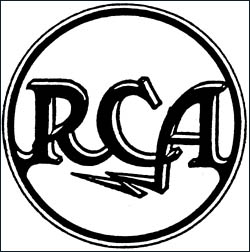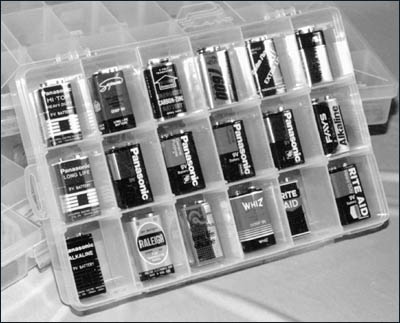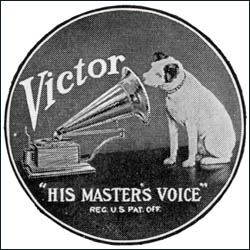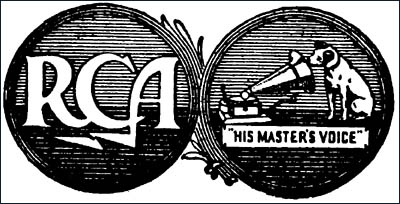Of Old Radios And Related Items--Published Monthly
The "True" Reasons RCA Bought Victor
BY PAUL Joseph BOURBIN
Web Edition
Due to a filing error, the following article was put "on hold" in our system. Despite the lapse of time since the letter that inspired the article was published, the topic continues to pique interest and promote further discussion and research. Responses are always welcome. (Editor)
I read with interest the letter to the Editor written by Oliver Berliner in the August 1999 issue of A.R.C. He states that Radio Corporation of America bought the Victor Talking Machine Company in 1929 to acquire the vast manufacturing and distributing system owned by Victor, as well as the most famous trademark. Indeed, this has been the official reason given since the purchase and is correct to a point. I feel that there were other reasons RCA bought Victor that were equal to RCA's need for manufacturing and distribution facilities.
The Role of Fred Gaisberg
At the very beginning of the phonograph industry, Fred Gaisberg started to make recordings for Columbia from both sides of the horn. During one of the early industry upheavals, he started working for Berliner's Gramophone Company as a recording engineer. He wisely determined, if recordings for home entertainment were to be profitable, the recordings would have to be of famous bands, singers, etc., that people knew and wanted to hear.
This concept was quite different from that of Edison who believed that people just wanted to hear the song or tune. He seemed uninterested in acquiring the services of famous performers and probably was not interested in paying their fees.
During another upheaval in the phonograph industry, Fred Gaisberg started working as a recording engineer for Eldridge Johnson's Victor Talking Machine Company. In addition to making the records, he had to hire the people to perform in front of the horn. His musical training and engaging nature aided him in securing the services of many of the greatest performers in the world. This brought Victor into preeminence amongst record companies. Fred Gaisberg became the senior recording expert for Victor, and later RCA, until his death.
Since Victor was the best known company, it was not difficult for Victor to sign exclusive recording contracts with most of its famous artists. Victor's lawyers were clever enough to write the contracts to prevent Victor artists from performing on radio without express permission from Victor. The management at Victor was very reluctant to permit its artists to perform on radio and only gave permission on special occasions. Victor viewed radio as a serious competitor and rightly so. The sales of records had started to decline with the advent of radio broadcasting, and the radio set was starting to displace the phonograph as the premier provider of home entertainment.
RCA and Control of Home Entertainment
Meanwhile, RCA was in the business of selling radio sets regardless of the manufacturer. Doc Herrold (founder of the predecessor of KQW) knew, as did Westinghouse (founder of KDKA and manufacturer of radio sets) that, if you want to sell radio sets, you have to give the public something to listen to. One of the reasons RCA started network radio was to provide high quality radio programs to a large audience. This would stimulate the sales of more radios. It also would allow great profits to be made from the sale of advertising.
One major obstacle was in the way -- Victor had exclusive contracts with many of the great performers of the time. Think of these contracts as having the same effect as the patent monopoly did for RCA earlier in the decade.

The progression of corporate logos that resulted in the RCA Victor logo. Top is the Victor Talking Machine Company's symbol taken from an original painting in 1901 by Francis Barraud, showing the dog "Nipper" listening to a Victor Type B phonograph. This trade mark was captioned "His Master's Voice." Center is the early Radio Corporation of America's logo, sometimes including the words "World Wide Wireless." Bottom is the familiar RCA Victor logo which incorporates both company symbols.
Control of patents and/or exclusive contracts would give RCA much power. Therefore, a major reason to acquire Victor was to own the performers' contracts that were a part of Victor's assets. This would free the artists to perform on radio.
Getting former Victor artists to perform on radio would happen more quickly than the conversion of the Victor plant to the production of radios. Thus, income from the purchase of Victor could be realized sooner. More radios and network advertising time would be sold, radio broadcasts could be used to stimulate record sales, and RCA's profitability would increase. This business arrangement could then move in a direction that would control the home entertainment industry.
RCA Eliminates Competition
Another minor reason, I believe, that RCA wanted Victor is that RCA wanted to end Victor's phonograph production. This is just speculation on my part. Victor Orthophonic phonographs sounded better than the electric phonographs of the time. True, the electric phonographs were louder, but the Orthophonics had a richer sound and were loud enough for most homes.
It might have concerned the management of RCA that Victor phonographs sounded better and buying the company was a way of getting rid of them and eliminating the threat of Victor coming up with a new design of radio or phonograph that would give RCA serious competition. Remember that the former Victor factory that produced Orthophonics was the first factory to be converted to radio production. The radio that was produced was a former Victor design (the R-32, RE-45, etc., series), not a new RCA design. Apparently the R & D facilities at RCA were not fully functional yet.
References:
Barnum, Frederick, O., III. His Master's Voice" in America. Camden, N.J.: General Electric Company, 1991.
Gelatt, Roland. The Fabulous Phonograph 1877-1977. New York: Collier Books, 1977.
Lyons, Eugene. David Sarnoff. New York: Pyramid Books, 1967.
Moore, Jerrold Northrop. A Matter of Records: Fred Gaisberg and The Golden Age of the Gramophone. New York: Taplinger Publishing Company, 1977.
Read, Oliver and Walter L. Welch. From Tin Foil to Stereo: Evolution of the Phonograph, Second Edition. Indianapolis, Indiana: Howard W. Sams & Co. Inc., 1977.
© September 1999, Paul Joseph Bourbin. All rights reserved.
(Paul Bourbin, 25 Greenview Ct., San Francisco, CA 94131)
Paul Bourbin's fascination with radio goes back to his teenage years. His collection spans the time from wireless to the transistor radio and consists largely of sets that he has saved from the junk heap and brought back to life. A past chairman and president of the Board of the California Historical Radio Society, he has written for various old radio publications.
Collecting Transistor Radio Batteries
By Marvin H. Hess
Web Edition
Most of us who collect transistor radios have opened the backs or the battery covers to discover a strange looking battery with corroded terminals. Although drained, many of the batteries still look like new. But, once removed, what to do with the batteries?
I decided to make a collection of them. The photo at right shows a few that have been culled from over 3,000 transistor radios.
Some radios have different size 9-volt batteries, and although I collect all sizes, my collection is mostly the oblong ones.
Some of the manufacturers changed their logo with time. Many stores have their own brand name, while import radios often have strange names. Unfortunately, there is no guide to batteries.
Of course, batteries have no value when drained. But, if you're interested in collecting them, look for the round 9- and 41/2-volt batteries, as well as the 221/2- and 30-volt ones. The mercury batteries could be collected also.
I house the batteries in compartmented plastic boxes bought at K-Mart; the type is Plano 3600.
(Marvin H. Hess, 204 Queensway Rd., Elma, NY 14059)

| [Free Sample] [Books, etc., For Sale] [Subscribe to A.R.C./Renew] [Classified Ads] [Auction Prices] [Event Calendar] [Links] [Home] [Issue Archives] [Book Reviews] [Subscription Information] [A.R.C. FAQ] URL = http://www.antiqueradio.com/Jul03_Bourbin_Reasons.html Copyright © 1996-2003 by John V. Terrey - For personal use only. Last revised: July 19, 2003. For Customer Assistance please contact ARC@antiqueradio.com or call (866) 371-0512 Pages designed/maintained by Wayward Fluffy Publications
Antique Radio Classified |

